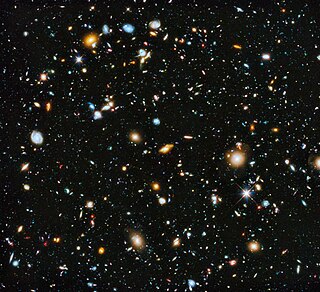
The Big Bang theory is the prevailing cosmological model explaining the existence of the observable universe from the earliest known periods through its subsequent large-scale evolution. The model describes how the universe expanded from an initial state of high density and temperature, and offers a comprehensive explanation for a broad range of observed phenomena, including the abundance of light elements, the cosmic microwave background (CMB) radiation, and large-scale structure.

Physical cosmology is a branch of cosmology concerned with the study of cosmological models. A cosmological model, or simply cosmology, provides a description of the largest-scale structures and dynamics of the universe and allows study of fundamental questions about its origin, structure, evolution, and ultimate fate. Cosmology as a science originated with the Copernican principle, which implies that celestial bodies obey identical physical laws to those on Earth, and Newtonian mechanics, which first allowed those physical laws to be understood. Physical cosmology, as it is now understood, began with the development in 1915 of Albert Einstein's general theory of relativity, followed by major observational discoveries in the 1920s: first, Edwin Hubble discovered that the universe contains a huge number of external galaxies beyond the Milky Way; then, work by Vesto Slipher and others showed that the universe is expanding. These advances made it possible to speculate about the origin of the universe, and allowed the establishment of the Big Bang theory, by Georges Lemaître, as the leading cosmological model. A few researchers still advocate a handful of alternative cosmologies; however, most cosmologists agree that the Big Bang theory best explains the observations.

Dark matter is a hypothetical form of matter thought to account for approximately 85% of the matter in the universe and about 27% of its total mass–energy density or about 2.241×10−27 kg/m3. Its presence is implied in a variety of astrophysical observations, including gravitational effects that cannot be explained by accepted theories of gravity unless more matter is present than can be seen. For this reason, most experts think that dark matter is abundant in the universe and that it has had a strong influence on its structure and evolution. Dark matter is called dark because it does not appear to interact with the electromagnetic field, which means it does not absorb, reflect or emit electromagnetic radiation, and is therefore difficult to detect.

The universe is all of space and time and their contents, including planets, stars, galaxies, and all other forms of matter and energy. The Big Bang theory is the prevailing cosmological description of the development of the universe. According to estimation of this theory, space and time emerged together 13.799±0.021 billion years ago, and the universe has been expanding ever since. While the spatial size of the entire universe is unknown, the cosmic inflation equation indicates that it must have a minimum diameter of 23 trillion light years, and it is possible to measure the size of the observable universe, which is approximately 93 billion light-years in diameter at the present day.
In physics, quintessence is a hypothetical form of dark energy, more precisely a scalar field, postulated as an explanation of the observation of an accelerating rate of expansion of the universe. The first example of this scenario was proposed by Ratra and Peebles (1988). The concept was expanded to more general types of time-varying dark energy and the term "quintessence" was first introduced in a 1998 paper by Robert R. Caldwell, Rahul Dave and Paul Steinhardt. It has been proposed by some physicists to be a fifth fundamental force. Quintessence differs from the cosmological constant explanation of dark energy in that it is dynamic; that is, it changes over time, unlike the cosmological constant which, by definition, does not change. Quintessence can be either attractive or repulsive depending on the ratio of its kinetic and potential energy. Those working with this postulate believe that quintessence became repulsive about ten billion years ago, about 3.5 billion years after the Big Bang.
In physics, there are four observed fundamental interactions that form the basis of all known interactions in nature: gravitational, electromagnetic, strong nuclear, and weak nuclear forces. Some speculative theories have proposed a fifth force to explain various anomalous observations that do not fit existing theories. The characteristics of this fifth force depend on the hypothesis being advanced. Many postulate a force roughly the strength of gravity with a range of anywhere from less than a millimeter to cosmological scales. Another proposal is a new weak force mediated by W′ and Z′ bosons.

Lisa Randall is an American theoretical physicist working in particle physics and cosmology. She is the Frank B. Baird, Jr. Professor of Science on the physics faculty of Harvard University. Her research includes elementary particles, fundamental forces and dimensions of space. She studies the Standard Model, supersymmetry, possible solutions to the hierarchy problem concerning the relative weakness of gravity, cosmology of dimensions, baryogenesis, cosmological inflation, and dark matter. She contributed to the Randall–Sundrum model, first published in 1999 with Raman Sundrum.

Lawrence Maxwell Krauss is an American-Canadian theoretical physicist and cosmologist who previously taught at Arizona State University, Yale University, and Case Western Reserve University. He founded ASU's Origins Project, now called ASU Interplanetary Initiative, to investigate fundamental questions about the universe and served as the project's director.

Bat-Mite is a fictional character appearing in American comic books published by DC Comics. Bat-Mite is an imp similar to the Superman villain Mister Mxyzptlk. Depicted as a small, childlike man in an ill-fitting Batman costume, Bat-Mite possesses what appear to be near-infinite magical powers, but he actually uses highly advanced technology from the Fifth dimension that cannot be understood by humans' limited three-dimensional views. Unlike Mxyzptlk, Bat-Mite idolizes his superhero target and thus he has visited Batman on various occasions, often setting up strange and ridiculous events so that he could see his hero in action. Bat-Mite is more of a nuisance than a supervillain, and often departs of his own accord upon realizing that he has angered his idol.
Quintessence, or Fifth Essence may refer to:
In astrophysics and particle physics, self-interacting dark matter (SIDM) is an alternative class of dark matter particles which have strong interactions, in contrast to the standard cold dark matter model (CDM). SIDM was postulated in 2000 as a solution to the core-cusp problem. In the simplest models of DM self-interactions, a Yukawa-type potential and a force carrier φ mediates between two dark matter particles. On galactic scales, DM self-interaction leads to energy and momentum exchange between DM particles. Over cosmological time scales this results in isothermal cores in the central region of dark matter haloes.

The Physics of Star Trek is a 1995 non-fiction book by the theoretical physicist Lawrence M. Krauss. It is the third book by Krauss, who later wrote a follow-up titled Beyond Star Trek in 1997.

Katherine Freese is a theoretical astrophysicist. She is currently a professor of physics at the University of Texas at Austin, where she holds the Jeff and Gail Kodosky Endowed Chair in Physics. She is known for her work in theoretical cosmology at the interface of particle physics and astrophysics.

The chronology of the universe describes the history and future of the universe according to Big Bang cosmology.

In physical cosmology and astronomy, dark energy is an unknown form of energy that affects the universe on the largest scales. The first observational evidence for its existence came from measurements of supernovae, which showed that the universe does not expand at a constant rate; rather, the expansion of the universe is accelerating. Understanding the evolution of the universe requires knowledge of its starting conditions and its composition. Prior to these observations, it was thought that all forms of matter and energy in the universe would only cause the expansion to slow down over time. Measurements of the cosmic microwave background suggest the universe began in a hot Big Bang, from which general relativity explains its evolution and the subsequent large-scale motion. Without introducing a new form of energy, there was no way to explain how an accelerating universe could be measured. Since the 1990s, dark energy has been the most accepted premise to account for the accelerated expansion. As of 2021, there are active areas of cosmology research aimed at understanding the fundamental nature of dark energy.

In classical physics and general chemistry, matter is any substance that has mass and takes up space by having volume. All everyday objects that can be touched are ultimately composed of atoms, which are made up of interacting subatomic particles, and in everyday as well as scientific usage, "matter" generally includes atoms and anything made up of them, and any particles that act as if they have both rest mass and volume. However it does not include massless particles such as photons, or other energy phenomena or waves such as light. Matter exists in various states. These include classical everyday phases such as solid, liquid, and gas – for example water exists as ice, liquid water, and gaseous steam – but other states are possible, including plasma, Bose–Einstein condensates, fermionic condensates, and quark–gluon plasma.
The zero-energy universe hypothesis proposes that the total amount of energy in the universe is exactly zero: its amount of positive energy in the form of matter is exactly canceled out by its negative energy in the form of gravity. Some physicists, such as Lawrence Krauss, Stephen Hawking or Alexander Vilenkin, call or called this state "a universe from nothingness", although the zero-energy universe model requires both a matter field with positive energy and a gravitational field with negative energy to exist. The hypothesis is broadly discussed in popular sources.

A Universe from Nothing: Why There Is Something Rather than Nothing is a non-fiction book by the physicist Lawrence M. Krauss, initially published on January 10, 2012 by Free Press. It discusses modern cosmogony and its implications for the debate about the existence of God. The main theme of the book is how "we have discovered that all signs suggest a universe that could and plausibly did arise from a deeper nothing—involving the absence of space itself and—which may one day return to nothing via processes that may not only be comprehensible but also processes that do not require any external control or direction."

Quintessence: The Search for Missing Mass in the Universe is the fifth non-fiction book by the American theoretical physicist Lawrence M. Krauss. The book was published by Basic Books on December 21, 2000. This text is an update of his 1989 book The Fifth Essence. It was retitled Quintessence after the now widely accepted term for dark energy.

The Greatest Story Ever Told—So Far: Why Are We Here? is the tenth full-length non-fiction book by the American theoretical physicist Lawrence M. Krauss. The book was initially published on March 21, 2017 by Atria Books.












